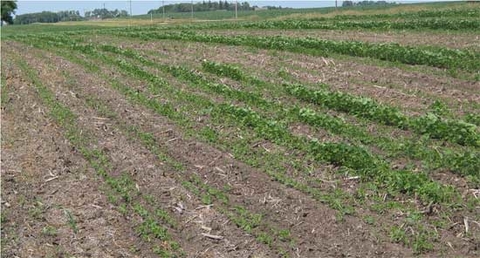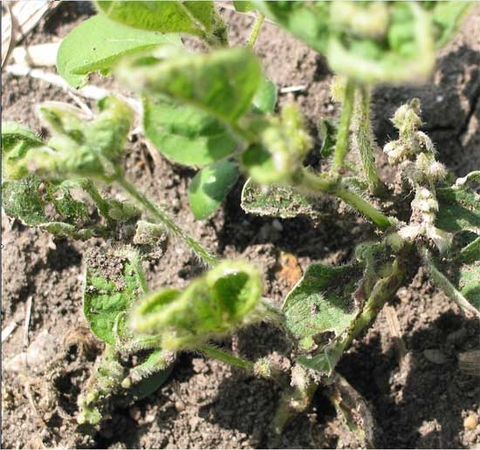Clopyralid and picloram herbicides are commonly used to control weeds in road ditches. Herbicide residues in forages can contaminate livestock manure and lead to crop injury during application. To prevent crop injury,
-
Always follow herbicide harvest or grazing restrictions
-
Test soil or forage for residues
-
Work with local, county or state transportation agencies
Harvesting grass and legumes along roadways is common, especially in western Minnesota. Ditch hay provides suitable forage for beef cattle, dairy heifers and horses. But ditch hay treated with picloram or clopyralid can lead to broadleaf crop injury via manure application.
This injury has reduced grain yields, and in some cases, resulted in total yield loss.
Common roadside herbicides
Picloram and clopyralid are herbicides that control unwanted broadleaf weeds in the following areas
-
Croplands
-
Rangelands
-
Pastures
-
Along roadways
These herbicides control hard-to-kill noxious weeds like thistles, without harming beneficial or planted grasses. As a result, local, county and state highway departments commonly use them along roadways.
Herbicides with aminopyralid are starting to replace picloram and clopyralid because they better control Canada thistle. But they pose the same risk to broadleaf crops from contaminated manure. Such cases haven’t been reported yet in Minnesota.
These products cause injury to sensitive crops, but there’s no documented history of human or livestock toxicity by picloram or clopyralid.
Crop injury from contaminated manure
When animals eat picloram- or clopyralid-treated hay, the chemicals pass through the animal and end up in their manure usually within a day or two.
In agricultural production, applying manure to fields is beneficial and common. Manure contaminated with picloram or clopyralid can harm or kill sensitive crops including:
-
Soybeans
-
Lentils
-
Peas
-
Legumes
-
Potatoes
-
Tomatoes
-
Peppers
Injured plants can exhibit twisting, leaf cupping, and loss of apical dominance. This results in short plants and abnormal side shoots.
Avoiding crop injury
Labels of many products containing picloram and clopyralid list restrictions important for those harvesting ditch hay.
-
Manure and urine containing these herbicides may cause injury to sensitive broadleaf plants
-
Don’t use treated plant material in compost.
-
Don’t spread picloram and/or clopyralid contaminated manure and/or compost on land used for growing susceptible crops. Contaminated manure may be spread onto fields that will be planted to grass crops (i.e. corn, small grains, or sorghum sudan forage).
Always read and follow warnings and recommendations on herbicide labels. These will vary between products. Some examples may include:
-
Don’t allow lactating dairy animals to graze treated areas within 7 days after application
-
Withdraw meat animals from treated fields at least 3 days before slaughter
-
Don’t harvest or cut the forage within 30 days after application
-
Don’t plant sensitive broadleaf crops in treated areas until a sensitive bioassay shows no detectable herbicide is present in the soil
If you carefully follow all the directions on the herbicide label, sensitive crop injury from manure applications should not occur.
Products containing clopyralid and picloram usually have a crop rotation restriction of up to 18 months for sensitive broadleaf crops. This is about two growing seasons in Minnesota.
Researchers in other states have dealt with treated ditch hay issues. They insist that relying solely on herbicide label restrictions isn’t enough to protect sensitive crops exposed to contaminated manure or compost. These researchers recommend soil analysis to detect clopyralid and picloram before planting sensitive crops.
Why restrict crop rotations?
Both picloram and clopyralid are,
-
Persistent and mobile in the soil
-
Readily absorbed and translocated throughout the plant
-
Chemically stable and intact in plants
Both herbicides have been found in groundwater, but only picloram has been found in Minnesota groundwater.
Picloram, clopyralid and aminopyralid don’t break down quickly in compost. The herbicide concentrations in relation to the organic matter can increase when you first store or compost the manure. It’s believed that clopyralid can remain in manure, forage/feedstuffs or compost for several years. Thus, composting contaminated manure isn’t a solution.
You can spread contaminated manure/compost on fields intended for nonsensitive crops like corn or small grains.
The following labs will test forage and soil samples for the presence of clopyralid to 1 part per billion (ppb) and will screen for the presence of picloram
-
Anatek Labs Inc (208-883-2839) in Idaho
-
Morse Laboratories Inc (916-481-3141) in California
Working with local, county and state agencies
If you harvest, feed and sell ditch hay, work with the local, county and state highway departments.
-
Identify which herbicides are used in the roadside weed control program
-
Determine which roadsides are spot treated and if some areas have broadcast treatments
-
Find out when roadsides will be treated
Working with local, county, and state agencies can reduce the risk of harvesting forages with unwanted herbicide residues. If you know and follow the herbicide’s harvest or grazing restrictions, you can harvest and feed the forage to livestock without contaminating manure.
Permitting
You need a permit if you plan to hay highway areas owned by the Minnesota Department of Transportation (MnDOT). You don’t need a permit on roadways where MnDOT only owns an easement.
You can get a permit by contacting MnDOT. The permit is free and MnDOT will notify you of any cutting restrictions due to herbicide use, wildlife habitat designation or calendar date restrictions.
Visit MnDOT’s website for more information on permits. Roadways owned by county and local governments have their own regulations, and farmers should contact their County or Township to obtain any cutting restriction information prior to harvest.
Bezdicek, D., M. Fauci, D. Caldwell, and R. Finch. 2000. Compost Quality: New Threats from Persistent Herbicides. Agrichemical and Environmental News, October 2000, Issue No. 174.
Cox, C. 1998. Picloram, Herbicide Fact Sheet. Journal of Pesticide Reform, 18:1 pages 13-20. http://www.pesticide.org/pesticide_factsheets
Cox, C. 1998. Clopyralid, Herbicide Fact Sheet. Journal of Pesticide Reform, 18:4 pages 15-19. http://www.pesticide.org/pesticide_factsheets
Reviewed in 2021



